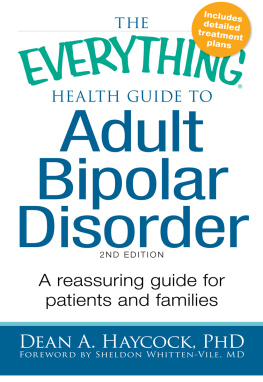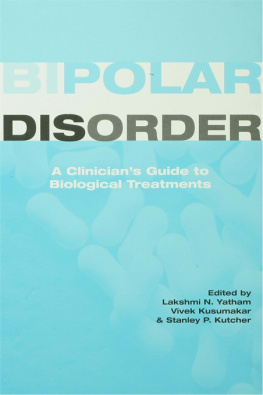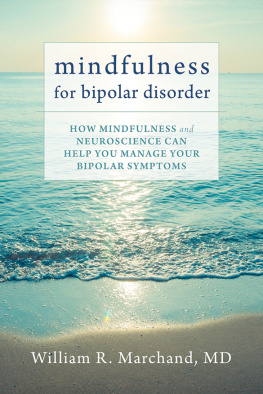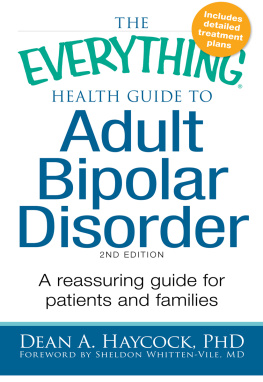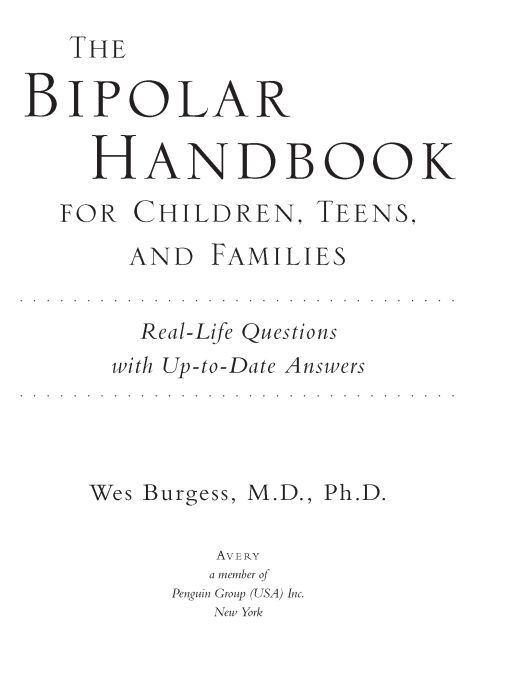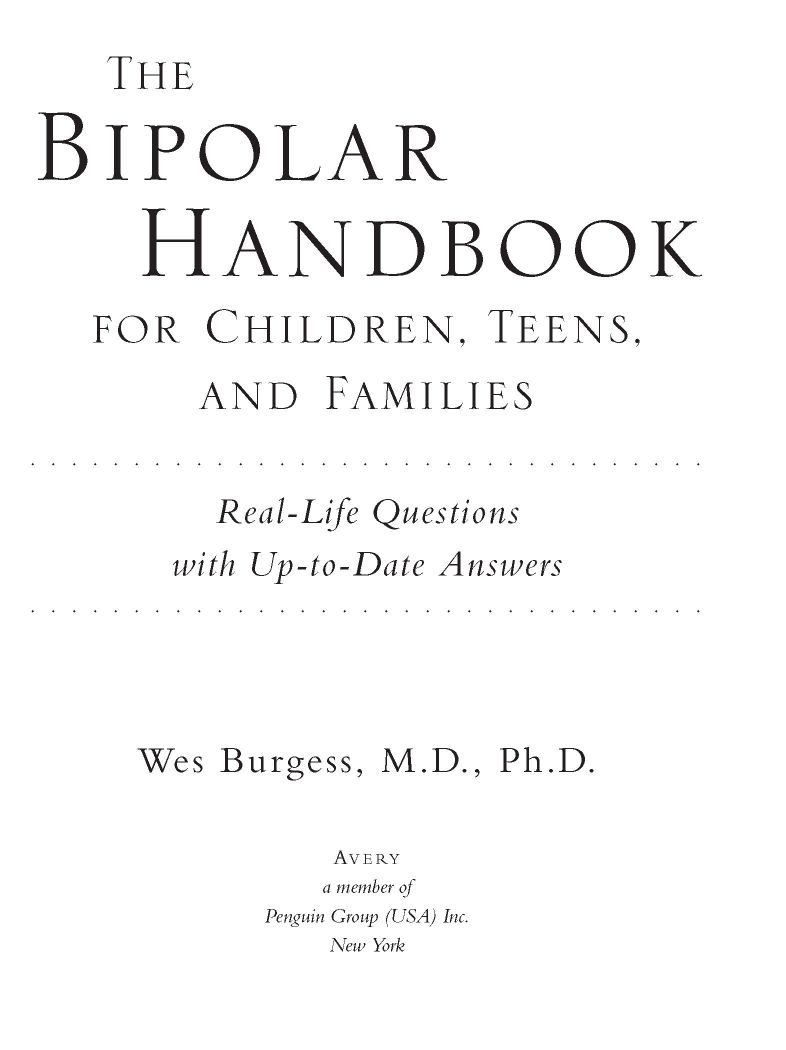Table of Contents
In another times forgotten space
Your eyes looked from your mothers face.
Like wildflower seeds on the sand and stone,
May the four winds blow you safely home.
ROBERT HUNTER
Introduction
Rebecca is in shock. The doctor has just told her that her daughter, Becky, has bipolar disorder. What is this illness? What can she do about it? How will her family cope? With his busy schedule, the doctor did not have time to sit down and answer her questions. Where can she go for answers?
Toms daughter Lori is depressed. Sometimes her pain is so great that she does not feel like living. She has been to doctors and therapists who treat depression, but nothing seems to help. Some of the medications even seem to make Loris depression worse. Tom would do anything for his daughter but he has run out of ideas. What can he do next?
Tracys young boy Richie cannot be calmed. He is up and down so much that he cant finish his meals. He talks constantly, and he throws a fit if he cannot have his way. The school counselor said Richie had attention deficit hyperactivity disorder (ADHD), but the treatments have only helped a little. Tracy has heard that some hyperactive children have something called bipolar disorder. How can she find out more about this condition?
Sue is sure there is something wrong with her child Bob, but she cannot get any satisfactory explanations for his condition. She consulted a therapist who told her that Bob is just anxious and he will grow out of it. The family doctor mentioned bipolar disorder, but he said he was not sure. How can Sue find out for herself?
Louis is a teen who has recently been treated for bipolar disorder and now is doing much better. However, his parents, brothers, and sisters are exhausted from helping him with his problems and the family is growing apart. How can they find out how to cope with his illness and stay healthy as a family?
You can find the answers to all these questions and many more in this book.
For the last twenty years, I have written down the most commonly asked questions from bipolar children, their parents, and their families. I have asked other professionals what questions they are asked about childhood bipolar disorder, and I scoured Internet Web sites and chat rooms to find questions that had not been satisfactorily answered by other patients doctors and therapists. The Bipolar Handbook for Children,Teens, and Families contains all of these most-asked questions about bipolar disorder with up-to-date answers. No doubt, you will find answers to your questions here.
The Bipolar Handbook for Children, Teens, and Families explains the illness called bipolar disorder, its causes, and how to recognize it. It discusses how to treat the illness with lifestyle changes, medications, therapy, and relaxation training. It addresses the difficulties parents experience making tough decisions that affect their childs health. There are chapters covering the everyday aspects of parenting and success in school, as well as how to prevent and deal with emergencies. An entire chapter is devoted to Internet sources for information, help, and support groups, and there are recommended book lists for parents and for children.
There are more than a million children with bipolar disorder in the United States. Most depression in children in this country is probably caused by bipolar disorder. The bipolar children who are mistakenly being treated for major depression, attention problems, obsessive-compulsive disorder, and autism are getting worse.
I wrote The Bipolar Handbook for Children,Teens, and Families to be like a friendly chat with a trusted family physician who knows how to address your own personal worries and fears and who solves problems like yours on a regular basis. I want it to be as if I were sitting down with you and your child face-to-face, so that I can give you individual counsel and cutting-edge information. I want to give you data that have not yet reached textbooks, reference books, or the press, in a form that is easy to understand and to use. Most of all, I really want to stimulate your desire to find out everything there is to know about helping your bipolar child to be healthy and happy. Lets not waste any more time.
WHAT IS BIPOLAR DISORDER IN CHILDREN?
In order to help our children with bipolar disorder, we must become experts on every aspect of the condition and learn every trick in the book. Only then can we be assured that our children will get the treatment, education, and opportunities that they deserve.
Bipolar disorder is a serious disease of the nervous system that affects children and adults. Changes in brain function and an imbalance in brain chemicals causes bipolar disorder, which in turn causes inappropriate emotions, thoughts, and behavior. In children, bipolar disorder is often first noticed when they begin to have poor school performance, poor attention, depression, or behavior problems.
What does the term "bipolar disorder mean?
The term bipolar disorder is somewhat of a misnomer, since it refers to an outdated characterization of pure mania alternating with pure depression (manic depression). We now know that bipolar disorder is a condition that affects many mental and physical processes and is much more than highs or lows. In addition to changes in happiness and sadness, bipolar disorder can produce emotions of anger, anxiety, avoidance, boldness, bravery, ecstasy, fear, idealization, irritability, jealousy, panic, resentment, and shyness in your child. Bipolar disorder can make it hard for your child to get to sleep, wake up, eat normally, and maintain normal body weight. Poor judgment, impulsivity, obsessive thoughts and behaviors, procrastination, and poor motivation affect your childs ability to learn and go to school. One of the most important problems your bipolar child faces is an increased vulnerability to stress, making it difficult for him or her to get past disappointments, frustrations, self-criticism, uncertainty, and confusion.
Until now, I only heard about bipolar disorder occurring in adults. Is it rare in children?
In 2003, a study by the Child and Adolescent Bipolar Foundation found that 750,000 children had bipolar disorder, beginning at preschool or older. With growing population and improved diagnosis, I estimate there are well over one million children with bipolar disorder in the United States. Through them, bipolar disorder affects the lives of their parents, grandparents, siblings, and friends. Psychiatrists, pediatricians, family doctors, psychotherapists, nurses, and social workers spend a large proportion of their time helping these children and their families reach health and happiness. If we include these people, I estimate that childhood bipolar disorder touches the lives of more than six million people in this country alone.
Studies show that 12 percent of bipolar children begin showing symptoms between five and nine years of age and 30 percent of bipolar cases start before fourteen years of age. Of course, this only includes the children whose bipolar disorder has been identified. More than half of the children suffering from bipolar disorder are misdiagnosed or never diagnosed at all.
Do you see many young children who have bipolar disorder?



